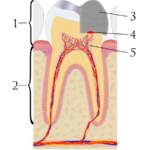
Vital pulp treatments (VTPs) are performed to maintain the vitality of the tooth. In recent years the emergence of calcium silicate–based biomaterials such as mineral trioxide aggregate (MTA) and calcium- enriched mixture (CEM) cement have seen increased interest in VTP.
The aim of this study was to assess the clinical and radiographic success of 4 different vital pulp treatments for deep caries management of mature permanent molars including teeth with clinical signs of irreversible pulpitis and the presence of apical periodontitis.
Methods
Patients aged 17-75 with 1 vital (closed apex) permanent molar with deep caries in close proximity to the pulp restorable with a direct restoration were randomised to receive one of 4 treatments;
Indirect pulp capping [IPC], direct pulp capping [DPC], miniature pulpotomy [MP] or full pulpotomy [FP]) using calcium-enriched mixture cement. Random allocation was disregarded when visible pulp exposures did not happen after complete caries removal and the tooth was transferred to the IPC arm. Pre-and intraoperative data recorded included vitality test results, pulpal/periapical status, and exposure type/location.
The primary outcome of the study was clinical/radiographic success. Clinical failure was determined by signs/symptoms of inflammation/infection (ie. swelling, abscess, sinus tract, and pain that could not be controlled by medication). Radiographic success was assessed using the following criteria: teeth with a normal contour/width of the periodontal ligament were judged as ‘‘healed’’; teeth with a clearly decreased size of the periapical lesion were judged as ‘‘healing’’; and teeth with an unchanged, increased, or new periapical lesion were judged as ‘‘failed’’.
The secondary outcome was pain. Pain was measured using a numeric rating scale before treatment and at 6, 12, 18, 24, 36, 48, and 60 hours; and at 3, 4, 5, 6, and 7 days post-treatment. Patients were followed up for 1 year with clinical and radiographic examinations at 3 and 12 months.
Results
302 patients were randomised (IPC-84; DPC-73; MP-76; FP-69).
Drop outs at 1 week, 3 and 12 months were 12 (4%), 26 (8.6%), and 68 (22.5%) respectively
Preoperative pain and apical periodontitis were significantly different among arms but not the case when the IPC group was excluded.
The reported 3- and 12-month success rates of the VPT techniques were comparable in the IPC (98.7% and 100%, respectively), DPC (98.4% and 94.7%, respectively), MP (98.4% and 91.4%, respectively), and FP (93.5% and 95.5%, respectively) arms, respectively (P > .05).
Conclusions
The authors concluded: –
Based on the results of this randomized clinical trial, various CEM/VPT techniques can be recommended for the management of deeply carious mature symptomatic teeth. Moreover, in vital closed- apex teeth, the clinical signs of irreversible pulpitis and the presence of apical periodontitis do not play an important role in treatment outcomes.
Comments
This is a relatively large randomised trial where a block randomisation was used although the block size used was not provided. In addition, the quality randomisation has been affected as patients that had been allocated to pulp treatments were switched to the IPC group if no pulp exposure was evident.
At 1 year the overall success rates reported seem to be high and given that more that 20% of patients are lost to follow up. consequently they are very likely to be an over estimate of the success rate. In the table below the success rates have been recalculated this time assuming that all those lost to follow up suffered a treatment failure. As treatment for some of those patients will have been successful this will be a ‘worst case’ scenario.
| IPC | DPC | MP | FP | |
| Patients at baseline | 84 | 73 | 76 | 69 |
| Success at 1 year | 65 | 54 | 43 | 47 |
| % success | 65/84 (77.4%) | 54/73 (73.9%) | 43/76 (56.6%) | 47/69 (68.1%) |
Although the study findings suggest that these techniques may be useful there is growing evidence to support either step down or partial caries removal approaches for the management of deep carious lesions (Dental Elf – 25th May 2017). These are more conservative options than the VPT options being tested in this study.
Links
Primary Paper
Asgary S, Hassanizadeh R, Torabzadeh H, Eghbal MJ. Treatment Outcomes of 4 Vital Pulp Therapies in Mature Molars. J Endod. 2018 Apr;44(4):529-535. doi:10.1016/j.joen.2017.12.010. Epub 2018 Feb 1. PubMed PMID: 29397215.
Other references
Dental Elf – 21st Jul 2017
Pulp capping carious exposures in adults: calcium hydroxide or MTA?
Dental Elf – 25th May 2017
Step wise caries removal sustained pulp vitality up to 5 years
Photo credits
Ian Furst, Goran tek-en CC BY-SA 3.0
